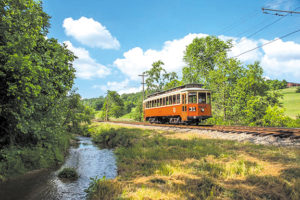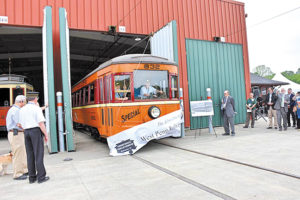 By Joe Curreri
By Joe Curreri Remember when one could ride a trolley from one end of the city to the other, on a real sightseeing trip? For the price of a nickel? Street cars were the means of transportation that one never tired of. From horse-drawn streetcars of the late 19th century to little Toonerville-like electric trolley, they grew to huge 60-foot-long cars seating about 60 passengers with an additional 20-30 people standing and holding onto overhead leather straps dangling from the ceiling. They made imposing monsters that other street vehicles would not challenge.
My memories of trolleys in Philadelphia, then the trolley capital of the world, contains many highlights such as my daily ride to work from South to North Philly and back on the Rt. 23 Trolley; hearing the clang of the bell by the motorman stomping his heel on the metal disc in the floor; relaxing, reading the paper or advertising cards above the interior windows; whizzing by and glancing into windows at heart-warming family scenes; conductors stopping the car at crossings to switch tracks with a crowbar; the trolley arm that changed at the end of the line so the car could go in the opposite direction; the curtain the motorman used at night when the car was lighted; and the buzzer cord that you pulled to signal your stop.
As the youngest child of five boys born to immigrant parents during the ’20s and ’30s, my greatest thrill was the summer weekends when the whole family went for picnics at Willow Grove Park or Woodside Park on the outskirts of Philadelphia. Open-air trolley rides through parks gave every poor city family a chance to enjoy God’s great pleasures. To this little kid, isolated in the vacuum of a teeming city, it was a fairyland. The clickety-clack of the rails, the fresh, cool breeze rushing through the open-air trolley, the smell of green foliage and summer flowers captured the imagination for all to enjoy.
 And then, I remember the boyhood pranks: flattening a penny on the trolley tracks, popping firecrackers on the tracks, and hopping the trolleys for a free ride. (One time, I hopped a trolley and stared eyeball to eyeball with my English teacher sitting in the back of the trolley. Subsequently, on my report card, I received a big “P” for English.) Some mischievous kids—ahem—snafued the trolley by running behind it and yanking the runner off the overhead wire. Then there were “trolley dodgers” (a street kid’s game of playing “chicken” with trolleys).
And then, I remember the boyhood pranks: flattening a penny on the trolley tracks, popping firecrackers on the tracks, and hopping the trolleys for a free ride. (One time, I hopped a trolley and stared eyeball to eyeball with my English teacher sitting in the back of the trolley. Subsequently, on my report card, I received a big “P” for English.) Some mischievous kids—ahem—snafued the trolley by running behind it and yanking the runner off the overhead wire. Then there were “trolley dodgers” (a street kid’s game of playing “chicken” with trolleys). It must have been even more fun when dinky streetcars were pulled by horses and mules. It was the network of street railways that more and more permitted workers in cities to commute to jobs beyond walking distance from their homes and shoppers to patronize other than local stores. By 1880 Philadelphia led all American cities in the length of its horse-car lines—some 264 miles of track.
By 1883, electricity transformed public transportation. Four-wheeled, 10-foot-long trolleys evolved, which often had a potbellied stove and two single-burner oil lamps.
The rolling stock gradually improved into bright, streamlined, graffiti-free, safe and reliable trolley cars, like the 1947 Presidents Conference Committee (PCC) trolley, now stationed on tracks below Philadelphia’s museum—The Transit Museum.
“This 18-ton trolley,” said Septa General Manager Louis Gambocini, “restored to its orginal beauty, is one of the finest transit vehicles ever designed.”
Visitors can board the gleaming trolley and ride in the sunshine of the past. I climbed aboard, sat down—and cherished the nostalgia for an American way of life that may be gone forever. Why?…Because city isolation began to break down. The city streets became full. Everything seemed to go faster and faster.
So, “where’s my trolley?” How do you say goodbye to an era? With a lump in your throat and tears in your eyes. How else? But there’s hope! Practically every major city in the country is developing plans for a comeback of the trolley.
For More Information about Philadelphia Trolleys:
• The Transit Museum and Store in Philadelphia, 1234 Market St., is open Monday through Saturday, 10 a.m. to 5 p.m. Admission is free. A television monitor takes you by video on a trolley ride. Nostalgic photos of trolleys are on display, and the store offers a varied selection of merchandise for children and adults, tourists and railfans. There is an entire wall of trolley and train books. Another wall is lined with videos. You can enter the PCC trolley in the downstairs concourse.
• The Pennsylvania Trolley Museum at 1 Museum Rd., Washington, PA 15301, is a museum dedicated to operation and preservation of streetcars and trolleys primarily from Pennsylvania, West Virginia and Ohio. It offers a trolley ride and provides a large photo exhibit of electric railway history along with souvenirs, videos, publications and trolleyana. In a 1984 episode of Mister Rogers’ Neighborhood, where host Fred Rogers takes a ride on and operates Philadelphia streetcar #5326. The world-famous “Streetcar Named Desire” from New Orleans is also shown at the Pennsylvania Trolley Museum near Washington, Pennsylvania.
Picture: Freshly restored West Penn Railways curved-side car no. 832 breaks through a banner to celebrate its return to service. The car was built by Cincinnati Car Company in 1929 and was part of the museum’s original collection when it was established in 1954.















Follow Us